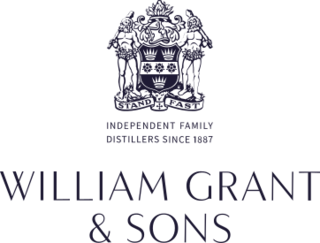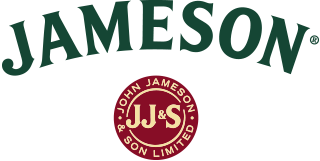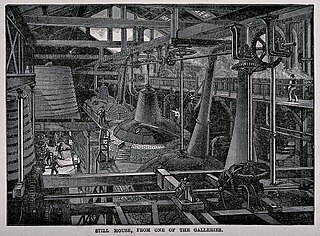
Whisky or whiskey is a type of liquor made from fermented grain mash. Various grains are used for different varieties, including barley, corn, rye, and wheat. Whisky is typically aged in wooden casks, which are typically made of charred white oak. Uncharred white oak casks previously used for the aging of port, rum or sherry are also sometimes used.

Irish whiskey is whiskey made on the island of Ireland. The word 'whiskey' comes from the Irish uisce beatha, meaning water of life. Irish whiskey was once the most popular spirit in the world, though a long period of decline from the late 19th century onwards greatly damaged the industry, so much so that although Ireland boasted at least 28 distilleries in the 1890s, by 1966 this number had fallen to just two, and by 1972 the remaining distilleries, Bushmills Distillery and Old Midleton Distillery, were owned by just one company, Irish Distillers.

The Glenlivet distillery is a Speyside single malt Scotch whisky distillery near Ballindalloch in Moray, Scotland, that produces single malt Scotch whisky. It is the oldest legal distillery in the Highlands of Scotland. It was founded in 1824 and has operated almost continuously since.

William Grant & Sons Ltd is an independent, family-owned Scottish company that distills Scotch whisky and other selected categories of spirits. It was established in 1887 by William Grant, and is run by Grant's descendants as of 2018. It is the largest of the handful of Scotch whisky distillers remaining in family ownership.

Tullamore Dew, rendered in most branding as Tullamore D.E.W., is a brand of Irish whiskey produced by William Grant & Sons. It is the second-largest-selling brand of Irish whiskey globally, with sales of over 1,500,000 cases per annum as of 2020.

Jameson is a blended Irish whiskey produced by the Irish Distillers subsidiary of Pernod Ricard. Originally one of the six main Dublin whiskeys at the Jameson Distillery Bow St., Jameson is now distilled at the New Midleton Distillery in County Cork. It is by far the best-selling Irish whiskey in the world; in 2019, annual sales passed 8 million cases. It has been sold internationally since the early 19th century, and is available to buy in over 130 countries.

Paddy is a brand of blended Irish whiskey produced by the Sazerac Company. As of 2016, Paddy is the fourth largest-selling Irish whiskey in the World.

Powers is a brand of Irish whiskey produced by the Irish Distillers subsidiary of Pernod Ricard. Historically a single pot still whiskey, the flagship Powers Gold Label brand was the first Irish whiskey ever to be bottled. Powers Gold Label was the best-selling whiskey in Ireland.
New Midleton Distillery is situated in Midleton, County Cork, Ireland. Established in 1975 and owned by Irish Distillers, a subsidiary of Pernod Ricard. Located alongside is the Old Midleton Distillery, which was established in the early 17th century and now operates as a visitor centre known as the Jameson Experience.

Girvan distillery is a grain whisky distillery located in South Ayrshire, Scotland.
Knappogue Castle Irish Whiskey is a brand of premium single malt Irish whiskey produced by the Irish Distillers subsidiary of Pernod Ricard. The brand is named for historic Knappogue Castle in County Clare, Ireland, originally built by Clan MacNamara in 1467. Knappogue Castle is known for bottling one of the oldest and rarest known Irish whiskies, Knappogue Castle 1951, a pot still whiskey produced at the now-defunct B. Daly Distillery.
Allman's Bandon Distillery was an Irish whiskey distillery which was established in 1826 in Bandon, County Cork, Ireland. The distillery closed in 1929 following financial difficulties. However, agents for the company trading under the name Allman, Dowden & Co., may have continued to sell off the existing stock which had built up in bonded warehouses, in both cask and bottled form, until 1939.
The Thomas Street Distillery was an Irish whiskey distillery located in Dublin, Ireland. At its peak, it was Dublin's largest and most productive distillery and with an output of over 2 million gallons per annum, twice that of John Jameson's acclaimed nearby Bow Street distillery. Alfred Barnard, a British author who visited most of the distilleries in the then United Kingdom of Great Britain and Ireland in the late 1880s, wrote that, at the time of his visit, the Thomas Street Distillery may have been the largest whiskey distillery in the world and probably had the highest output of any whiskey distillery in the British Isles. However, the distillery later entered into financial difficulties, and closed in 1926. Although most of the distillery buildings were demolished following its closure, a few were incorporated into the Guinness St. James's Gate Brewery and are still extant.

Teeling Distillery is an Irish whiskey distillery established in Dublin in 2015 by the Teeling Whiskey Company and owned by Bacardi Limited.

The Dundalk Distillery was an Irish whiskey distillery that operated in Dundalk, County Louth, Ireland between 1708 and 1926. It is thought to have been one of the old registered distilleries in Ireland. Two of the distillery buildings, the grain store and maltings, still exist and now house the County Museum and Dundalk Library.
The Watercourse Distillery was an Irish whiskey distillery which was established in Cork City, Ireland in 1795. In 1867, the distillery was purchased by the Cork Distilleries Company (CDC), in an amalgamation of five Cork distilleries. Following the amalgamation, the distillery was mothballed for a period at the beginning of the 20th century. However, operations at the distillery were later resumed, with production of yeast, industrial alcohol and grain alcohol occurring at the distillery until the 1970s. Distillation ceased at the facility in 1975, when Irish Distillers, who at that stage owned the Watercourse along with several other distilleries in the Republic of Ireland consolidated its operations in a new, purpose-built distillery in Midleton.
The Old Tullamore Distillery was an Irish whiskey distillery which was established in Tullamore, County Offaly, Ireland, in 1829. The original home of Tullamore Dew Irish whiskey, the distillery closed in 1954, having endured financial difficulties for many years, like many Irish whiskey distilleries of the early 20th century.

The Dublin Whiskey Distillery Company Jones Road Distillery, also known as the D.W.D. Distillery, Jones Road, or just Jones Road Distillery, was one of the six great Irish whiskey distilleries of Dublin city visited and documented by Alfred Barnard in his seminal 1887 publication "The Whisky Distilleries of the United Kingdom". It was located on the north side of the city on the banks of the River Tolka, approximately a mile north of the city centre. The distillery was built by the Dublin Whiskey Distillery Company Ltd and the Irish whiskey produced sold around the world under the brand name D.W.D.

The following outline is provided as an overview of and topical guide to whisky:













